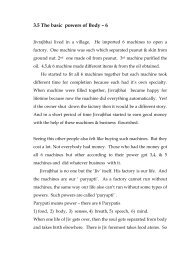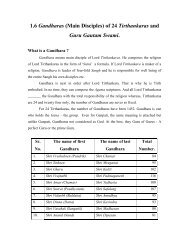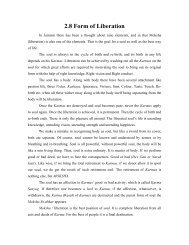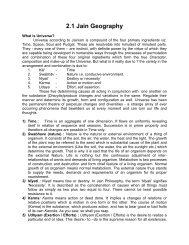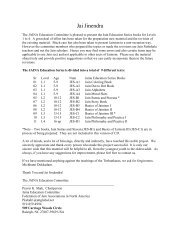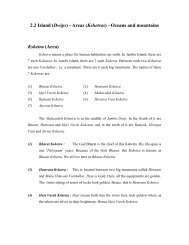3.4 Jain Biology. - Jainism, Jain Religion - colleges
3.4 Jain Biology. - Jainism, Jain Religion - colleges
3.4 Jain Biology. - Jainism, Jain Religion - colleges
You also want an ePaper? Increase the reach of your titles
YUMPU automatically turns print PDFs into web optimized ePapers that Google loves.
<strong>3.4</strong> <strong>Jain</strong> <strong>Biology</strong>.<br />
In world we find different kinds & different nature of people. We can find in<br />
Guinness Book of records that some people have skillful abilities, some are<br />
strong & some are weak, why? Every body has some organs & same things<br />
in the body, still why is that difference between similar people? We all know<br />
that our bodies are made up of Panchmahabhut (5 elements). But what are<br />
the basic elements of this body. What kind of body do Gods & Goddesses<br />
(Dev, Devi) have? What’s the kind of the body of those in Hell? Tiriyanch has<br />
which body ? What are the other body kinds & how many ? All these<br />
querries have answers in <strong>Jain</strong> <strong>Biology</strong>. Bodies are of 5 types :- 1) Aaudarik,<br />
2) Vaikriya, 3) Aaharak, 4) Tejas, 5) Kaarman.<br />
1) Aaudarik Body :- Animals, Birds, Humans have this Body. It’s made<br />
up of “Audarik karma vargana Pudgals “ (i.e. the Particle collected by the<br />
soul when they are born as an animal, bird or Human) ‘Aaudarik’ word<br />
comes from udaar – a gujarati word which means Generous, if understood<br />
technically then this is the body with which austerities if done then can<br />
attain salvation. One needs only this kind of body to reach the stage of<br />
liberation.<br />
2) Vaikriya Body :- The construction of this body is like ‘Mercury’. It’s<br />
made up of ‘Vaikriya Pudgal” i.e. mercury like particles . Whenever wished<br />
this body can be made big /small, beautiful or ugly, divide in parts. This is<br />
the body which is received in heaven & hell. They get the body as soon as<br />
they are incarnated in respective places, i.e. in our world first, one is born then<br />
grows to be young and then old. But for Vaikriya Body they directly get the<br />
body of an adult & don’t have the process of growth from child to old. This<br />
body can bear any kind of attack. It cannot end before it’s decided lifetime.<br />
Whereas here an accident can end our life before time.
3) Aaharak Body :- This is the kind of the body which some great saints can<br />
possess after attaining the level of 6 th Gunsthanak. For which they have to<br />
do high level of austerities, & get the knowledge of purvadhar level. They ,<br />
with their abilities can made a different body which is very white, beautiful<br />
& minimized, that body can travel to Tirthankara’s samavsaran & ask their<br />
doubts & return . They already have audarik body which is sitting in<br />
original place, & their aaharak body goes & comes back.<br />
The present saint categories with their leaders are mentioned as below :-<br />
Tapagachha<br />
Aacharya Group Aacharya Group<br />
A. Ramsuriji Shree Dahelawala A. Premsuriji Shree Ramchandra<br />
Suri<br />
A. Siddhisuriji Bapji Maharaj B.Premsuriji BhuvanBhanu<br />
Suriji<br />
Nemisuriji Shasan Samrat Nitisuriji Nitisuri<br />
Kanak suriji Vaagadwala Shantichandra Suriji Shantichandra suri<br />
Bhakti Suriji Bhakti Suri Buddhisagar Suriji Buddhisagar Suri<br />
Kesar Suriji Kesar Suri AanandSagar Suriji Sagarji<br />
Mohan Suriji Dharma Suri Himachal Suriji Himachal Suri<br />
Vallabh Suriji Vallabh Suri Amrut Suriji Halari<br />
Others<br />
Achalgachh -<br />
A. Gunoday Sagar Suriji<br />
Paychand gachh - Vrudhichandra Suriji<br />
Khartar gachh - Kantisagar Suriji<br />
Vimal gacha - Shantivimal Suriji<br />
Tristutik gachh - Rajendra Suriji.<br />
( Stanakvasi)
In vikram savant 1508, there was a rise of a view namely ‘Lokashah’ that<br />
denied idol worship, and it accepted the 32 <strong>Jain</strong> aagams where there was no<br />
mention of Idol warship. It went against those religious activities in the<br />
temple where minute violence could occur. In 1636 AD Saint Lavji dared to<br />
tie a cloth piece on his mount and this is still practiced today. In the start,<br />
from the names launka and then Dhundhu swami, the names ’ sthanakvasi’<br />
(living in upashrayas/ religions hall) became famous. Presently there are 24<br />
groups in this category listed as below.<br />
1) Akhil bharatiya Shwetambar Stanakvasi group.<br />
2) Gyan gachh 7) Dharamdasji<br />
3) Sadhu Margi 8) Nanak Swami<br />
4) Ratna Vansh 9) Muni Mayaramji <strong>Jain</strong> Sangh<br />
5) Jaimala gacha 10) Hukum gacha<br />
6) Maya ramji 11) Hungami – lalji.<br />
12) Vardhaman Vitarag 13) 6 Koti limadi ajaramar<br />
14) Gondal mota paksha 15) Limbdi Gopal<br />
16) Dariyapuri 8 Koti 17) Kachch 8 Koti moti group<br />
18) Kachch 8 Koti nani group 19) Botad sampradaya<br />
20) Sayla Sampradaya 21) Gondal Sanghani<br />
22) Barwala sampradaya 23) Khambhat Sampradaya<br />
24) Halari Sampradaya<br />
There are a majority of nuns (female monks; sadhvis ) in these 24 groups.<br />
(Terapanthi)<br />
From the sthanakavasi group in vikram savant 1817, arya Raghunath’s<br />
student, saint Bhikamji started the terapanthi group. He dinied the religious<br />
belief of non violence of the minutest life. So he separated and henceforth 13<br />
monks started their own group which is divided into 3 categories.
1) Nav Tera panthi samuday<br />
2) Arhad Sangh Sampraday<br />
3) Sanmati Sangh Sampradaya<br />
Presently, the young student Mahapragnyaji of arya Tulsi is considered best<br />
amongst them. This group is known for following only one aacharaya and his<br />
preaching.<br />
II. DIGAMBAR<br />
They believe that all the monks of Mahavir didn’t wear clothes. <strong>Jain</strong>ism was<br />
divided into 2 groups namely Shvetambar & Digambar in 606 vir savant.<br />
They believe that God’s preaching are not present in its original form. They<br />
don’t accept the religious scriptures (agams). They don’t believe that females<br />
also can become siddh. They carry a wooden bowl and peacock feathers and<br />
they eat from there hand . They don’t put eyes, forehead and waist<br />
ornaments on God’s statue. They consider the scriptures holy that were<br />
written by kundkundacharya. The founder of this group is believed to be<br />
arya Shivbhuti. There are also many subcategories in this group namely<br />
Bispanthi, Terapanthi, totapuri, Guman panthi, Samaiya etc.<br />
Presently arya vidyasagar of Terapanthi group is the main leader.<br />
Conclusion<br />
Every if different groups and categories have been formed by the <strong>Jain</strong><br />
followers, based on their differences, still non violence has remained the most<br />
important in all forms, Unlike other religious, violent incidents don’t happen<br />
here. Ultimately lord Mahavir's main preaching and principals – following<br />
Rathatrayi to gain immortality(moksha), 5 major vows, 7/a elements, 2<br />
Tirthanksrs, chastity etc., have been accepted by all groups unanimously.<br />
And it is speead all over the world like a huge banyan tree.
1.1<br />
The ancientness of <strong>Jain</strong>ism and its usefulness.<br />
There are proofs of existing of 12 to 13 religions in the world namely<br />
Hinduism, Buddhism, Christianity, Islam etc. But the presence of <strong>Jain</strong>ism is<br />
different and assertive of all. We can come to know about the ancientness of<br />
<strong>Jain</strong>ism from the following points.<br />
PROOF – 1<br />
1) Based on the hand actions ( Mudras) of the statues in the reins of the<br />
most famous ancient civilization of India, the mohenjodaro & Harappa<br />
civilization. Shree Chandra wrote in is modern review on August 1932 that<br />
the statues standing in this position are doing the action named ‘Kayotsarg’<br />
Where one has to stand and meditate and this action is most popular amongst<br />
the <strong>Jain</strong> monks. This action can also be seen in the famous statue of<br />
Rishabhdev, kept in mathura museum. Also a nude male statue with<br />
swastika mark has been found which characterize the 7 th Tirthankar… of<br />
<strong>Jain</strong>ism.<br />
Mrs. Gu sana believes that in the ancient Indian literature the knowledge of<br />
soul was spread in the areas surrounding north eastern Ganges & <strong>Jain</strong>ism<br />
flourished there. There is no mention of soul knowledge in the Vedas but<br />
later on its presence was authenticated by the six Upanishads. This is to be<br />
noted.<br />
2) In the ancient manuscripts of Hinduism, like rigveda, yajurveda,<br />
Manusmriti, yogavishishta, there is mention of Rishabdev & other tirthankars,<br />
Their renunciation, gain of ultimate knowledge, Moksha, etc, are mentioned.<br />
3) The interesting discoveries of foreign experts like Dr. Lermeu yakobi,<br />
Dr. feuru, Prof L.D. Barnot, A.A. Mcdonald, Major J.G.R. Furlog, etc., revel
that the ancientness of <strong>Jain</strong>ism is more than the origin of Hinduism and it is<br />
characterized by its much disciplined laws and strong elements of being a<br />
monk.<br />
4) Famous Indian archeologist Dr. S. Radhakrishnan. mention the<br />
ancientness of <strong>Jain</strong>ism its heritage and its foundation by the scriptures &<br />
writings. It is proved from it, that the law of non violence preached by<br />
rishabhadev was present & famous even before the time, the Aryans came to<br />
India.<br />
Vidya bhushan notes that “ The roots of <strong>Jain</strong>ism go to the beginning of the<br />
world and <strong>Jain</strong> knowledge is more ancient than nay other scripture & I don’t<br />
hesitate to make this Statement”.<br />
The judge of Madras and Bombay High court, Justice Ranganakar also<br />
presented different proofs to authorise the above statement.<br />
USEFULNESS<br />
1) The way of purity - This major and important usefulness is a must for<br />
the over all development of the world. <strong>Jain</strong>ism gives undisturbed authority to<br />
live best life. It forbids the killing of even the tiniest insect. The thinking<br />
process and its active approach helps a man completely to gain immortality<br />
and cleanliness of thought & speech.<br />
2) The way of holiness – to the point preaching of truth, non violence, non<br />
greediness, control are there in the roots of a holy life. There is a feeling of<br />
love towards a person, family, country and the whole world. In the same<br />
way, Religious scripts give the rules of kindness, study, love, non attachment<br />
, etc to the common man, and try to evoke his purity and broad mindedness.<br />
Thus , through these good qualities, one can gain not only humanity but going<br />
further ahead we can gain greatness, saint ness holiness and completeness.
To the luxurious people, these religion rules look coarse and hard from<br />
outside, but the <strong>Jain</strong> saint organization and people follow it at their will to be<br />
free from ‘Karma’ and lust. Due to this the religious roots of pure thought<br />
and action get seeded deep into our blood. Thus the clear aim, road of act<br />
and clear perception are related to the ‘endless’ and forever’. They are the<br />
only ones capable and necessary for the complete development of life.<br />
1.2<br />
resent Groups of <strong>Jain</strong>ism and its qualities<br />
<strong>Jain</strong>ism<br />
Shwetambar Group<br />
Digambar Group<br />
Murtipujak Sthanakvasi Terapanthi Bispanthi Terapanthi<br />
What does sampaday (Group) mean ?<br />
Amongst the many rules and regulations of the religion some are mainly<br />
portrayed and they one followed and accepted by certain groups.<br />
What does Shwetambar mean ?<br />
Those who wear white clothes for lifetime and meditate to become God are<br />
called Shwetambars.<br />
What does Digambar mean ?<br />
Clothes are a hindrance to attain ultimate knowledge. Therefore you<br />
meditate to be like God without wearing clothes.
I. SHWETAMBAR (murtipujak / idol worshippers )<br />
They accept the temple, Idol worship, 45 aagams (& Scriptures<br />
attesting Gods Preaching). After the 2 nd successor of God, likely – arya<br />
Vajraswami or Arya Bhadrabahu, in vir savant 609, the two groups namely<br />
shwetambar & Digambar were formed. This is a proved theory. In the 6/7<br />
century AD, there were 84 gachha (saint groups) based on the different beliefs<br />
of the 84 students of arya Udhyotan.<br />
These group present today one namely- Tapagacha, Achalgacha,<br />
Payachand gacha, Khartar gacha, Vimal gacha, Tristutik gacha etc. Amongst<br />
all, the shwetambar tapagacha group of shree devsuri is most famous since<br />
last 2/3 centuries. And the 71 st successor namely shree Manivijay dada and<br />
other monks and their family have lately been most famous.<br />
1.3<br />
The future according to <strong>Jain</strong>ism. The 6 th aaro ( era)<br />
The look of the 6 th era.<br />
The 6 th aaro starts after 21000 yrs, of the 5 th aaro passes by.<br />
This 6 th aaro is also of 21000 yrs.<br />
The sad and sorrowful environment starting towards the end of 5 th aaro will<br />
prevail throughout the 6 th aaro, and it will get doubled day by day. The height<br />
of man will be maximum of 2 hands in the start and it will decrease towards<br />
the end of the era, being slightly less than I hand. Maximum age of a man will<br />
be 20 years while a woman lives upto 16 years. These people will live in<br />
caves. Only for 3 hours in the morning and evening, they will come out of<br />
their caves to catch fish in the river. This is because in the morning after 3<br />
hours it gets very hot and at night it gets extremely cold. The hunted fish are<br />
thrown on the river bank and due to extreme heat & cold, these fish get
cooked and dried respectively and one then eaten. The fish need to be cooked<br />
and can’t be eaten raw because these people will not have a strong digestive<br />
system.<br />
Also the body of such people will be out of shape, ugly and awefully smell.<br />
Their behavior will be without any thoughtfulness & the female crowd will<br />
behave without any respect for big or small like animals. They will be<br />
shameless. The ladies will conceive at the age of 6. people will have no<br />
religions values, will be of extreme cruel intentions, will eat man’s dead body<br />
and most of them after dying will go to hell. After 21000 years of 6 th arro get<br />
over, the descending time (Avsarpini Kaal) gets over.<br />
After the end of Avsaipini kaal, the Utsarpini ( ascending time) starts. Where<br />
showly and gradually, thing start becoming better.<br />
1.4<br />
Lord Mahvir’s meditation, influence & previous births.<br />
Lord Mahavir had renounced the world in 629 BC and had gone on the tough<br />
path to gain the knowledge of soul. He believed that there was a bond more<br />
stronger them the silk or iron chains, There is no bond like of a body with<br />
sense & mind. To break these bonds, he left the attachment of body, turned<br />
his senses towards inner life and coupled mind with religion. To break his<br />
karmas, he himself went to the land of sins, he beared all the accusations of<br />
fools with a smile, he stood firm facing all difficulties and also beared the 22<br />
internal difficulties without any pessimism.<br />
Does meditating mean bearing ?<br />
Lord Mahavir wanted to free the world from sorrow in real senses. But he<br />
himself had to be powerful enough for this. So he meditated with many<br />
impossible vows continuously for 12 ½ years. He totally did 4166 fasts
without water during his renunciation period. Sometimes he did fast for<br />
continuous 6 months, 5 months, and 25 days, 2 months, 1 ½ months, 15 days,<br />
3 and 2 days. He didn’t eat for consecutive 2 days and in a day he hardly ate<br />
one meal. Even during those times, when lord Mahavir was disturbed by<br />
goshalo, goval, samgam dev, kaputha, chandakaushik snake who bit him or<br />
by people who cooked food on his feet, he silently bared all pains. He never<br />
blamed anybody or defenced himself and he became, in turn, more pure.<br />
The Goal of meditation<br />
One questain arises that how can a soul having a body, bear all these /<br />
We get two answers for this. One is that lord Mahavir’s intellect was of the<br />
topmost lever and he would remain deep into meditation. While meditating,<br />
his soul would be very strong and powerful and on the level of body one<br />
would feel that God is not living.<br />
Secondly, God treated himself with strictness and was warm & soft towards<br />
other people. Due to this he didn’t have to consciously try, to bear all the<br />
difficulties.<br />
What does lord Mahavir’s meditation mean<br />
• Change yourself before you change the world.<br />
• Follow fasting to break the diseases of body<br />
• Meditate for purity if mind<br />
• For peace of mind, practice silence and follow loneliness.<br />
• Sleep less to be alert always. (God slept for total 48 mins in 12 ½ years)<br />
• Don’t have interest towards wanted and anger towards unwanted.<br />
• Leave all the forms of thought relating to sorrow/happiness, like/dislike.<br />
• To completely destroy ego, drink the sweetness of soul’s quality.
What did lord Mahavir gain from his meditation ?<br />
He gained calmness, core for all living bengs, non violence, forgiveness,<br />
detachment etc, qualities. These qualities were woven into his soul and very<br />
easily he gained many other qualities and also the ultimate knowledge –<br />
kevalgyan.<br />
Effect of meditation<br />
Due to this meditation he became ‘Tirthankar’ (God) at the age of 42 ½ years.<br />
He was also called Jina, Arihanta, Vitrag. All the people bowed to him. Kings<br />
were happy and they worshipped him. All the angels (devas) and Indras<br />
praised him. 34 ‘atishayas’ (external adornment) came alive. God’s speech<br />
became best, adorned by 35 qualities. All violent animals became quiet. All<br />
the sorrows of men were so pressed. People got happiness. Fools get true<br />
knowledge. Veracious people and sinners became non violent and true<br />
humans. The true and good people gained Samkit (true knowledge). Wise<br />
men took renunciation. Lord Mahavir gained Moksha the ultimate goal with<br />
reinforcing force towards knowledge and meditation. In pleasant times also,<br />
the royal ness and completeness of <strong>Jain</strong>ism is flourishing, and all this is due to<br />
lord Mahavir's good will.<br />
Lord has played a major role in giving the world a non violent religion.<br />
<strong>Jain</strong>ism has stood firm with its charismatic personality and the credit foes to<br />
lord Mahavir who is the root of the religion.<br />
Lord Mahavir 27 reincarnations.<br />
No. Life Age Important information<br />
1 Nayasar - Gained true knowledge for first time in western<br />
mahavideha.<br />
2 Saudharma<br />
devlok<br />
1<br />
palyopome<br />
Enjoyed blissfulness<br />
3 Marich 84 lakh<br />
purva<br />
Was the grandson of Shree Rishabhdev, he was<br />
tridandik monk. His life cycle in creased due to
wrong preaching and was destined to belong to<br />
a lower caste due to the ego of his heritage.<br />
4 Bhramadevlok 10<br />
Blissfulness<br />
sagaropam<br />
5 Kaushik<br />
Bhrahman<br />
80 lakh<br />
purva<br />
In kollak village, adorned tridandik attire, died<br />
and had many small insignificant births.<br />
6 Pushpamitra 72 lakh Was a tridamdik in Sthuna city<br />
purva<br />
7 Saudharma Medium Blissful<br />
devlok<br />
8 Agnidhyot 60 lakh Was a tridandik in Chaitya village.<br />
purva<br />
9 Ishaan devlok Medium Blissful<br />
10 Agni Bhuti 56 lakh Tridandik in Mandir Village<br />
purva<br />
11 Sanatkumar Medium Blissful<br />
devlok<br />
12 Bharadwaj 44 lakh Tridandik monk in Shwetanrpi city<br />
purva<br />
13 Mahendra Medium Blissful, from here he had many small births.<br />
devlok<br />
14 Sthavar 34 lakh Tridandik in Rajgruhi city<br />
Brahman purva<br />
15 Bhrahma Medium Blissful<br />
devlok<br />
16 Vishwabhuti<br />
prince<br />
1 crore yr. became saint, threw the cow up in the air, took a<br />
vow and did ’anshan’ (left food and water) at<br />
his end time.<br />
17 Mahashukra<br />
devlok<br />
Maximum Living blissfully to the fullest.<br />
18 Triprustha<br />
vasudev<br />
19 7 th Narak<br />
(hell)<br />
Tamastah<br />
84 lakh yrs. Poured hot oil in farmers ears due to which he<br />
gained stubborn karmas, was in the city of<br />
Potanpur.<br />
- Sorrow.<br />
20 Lion - Had many other births after being lion<br />
21 4 th Narak<br />
(hell)<br />
- Had many births of animals and insects after<br />
this life.<br />
Pankprabha<br />
22 Vimal prince - loved and cared for all. Renounced the world<br />
and did difficult meditation.<br />
23 Priyamitra<br />
chakravarty<br />
24 Mahashukra 17 Blissful<br />
84 lakh yrs. Became students of pottilacharya and<br />
renounced the world. Did extreme meditation<br />
for 1 crore years.
devlok sagaropane<br />
25 Saint Nandan 25 lakh yrs Was a king and then renounced the world.<br />
Worshipped the 20 sthanks with 11,80,645<br />
monthly fasts, and thus gained the authority of<br />
being a tirthankar.<br />
26 Pranat devlok 20<br />
Had bliss in pushpottar vasantak plane.<br />
saganopane<br />
27 Vardhaman<br />
kumar<br />
72 years Born in Kshatriyakund (Bihar)., father was king<br />
Siddhartha and nother was Trishaladevi. Was<br />
the 24 th tirthamkar. Did extreme meditation for<br />
12 ½ years. Get kevalgyam at the age of 42 ½<br />
yrs and gained salvation at the age of 72 yrs at<br />
Pavapuri.<br />
Summary<br />
14 births of man<br />
10 births of angel (deva)<br />
1 births of animal<br />
2 births in hell.<br />
Was a vasudev in the 18 th birth, a chakravarti in 23 rd birth and a tirthamkar<br />
named Mahavir on his 27 th birth.<br />
1.5<br />
Introduction to the 24 tirthankars and the importance of number 24 what does<br />
Tirthankar mean ?<br />
Those who have gained victory of love and hate and who have started <strong>Jain</strong>ism<br />
are called as tirthankars. They show people the right way to be free from<br />
foolishness, sorrow and lust .<br />
What do tirthankars do ?
The founder of <strong>Jain</strong>ism are tirthankars. They are the holy element of <strong>Jain</strong>ism.<br />
They have gained the ultimate level of everything, and kevalgyan with<br />
meditation. Their strategies are based on the want of immortality and<br />
salvation. Their way is of giving forgiveness, friendship love to all, and<br />
following non violence. Their view of life is big and without any want. Thus<br />
the lifestyle has to be free from greed and karma.<br />
The introduction of holy Tirthankars in short.<br />
Why are the tirthankars only 24 ?<br />
This is answered by the 87 th hymn of the scripture ‘Yashtilak Mulika’ written<br />
by Somdevsuri. It is mentioned that though there are many stars and planets<br />
but according to nature’s rule its number is fixed. Likewise in the descending<br />
and ascending span of the time wheel, these planets are positioned at their<br />
best only 24 times. Even this happens as decided, so 24 Tirthankars are born<br />
during there times. Thus 24 Gods – no less, no more.<br />
Introduction of Tirthankars<br />
Sr. Tirthankar<br />
No.<br />
1 Rishabhdev<br />
(Aadinath)<br />
Information<br />
Had a tattoo of bull on his thighs. In the 14 dreams<br />
his mother Marudeva first saw bull. Was called<br />
Adinath also because he was the one to start(adi)<br />
religion after 18 kodakodi saganropam.<br />
2 Ajitnath While playing chess, mother Vijaya rani continuously<br />
won(jit) against father Jitshatru. . He also conquered<br />
over enemies like lust etc.,<br />
3 Sambhavanath After his birth, there was plenty of wealth and grains.<br />
All famines died away and one saw the<br />
possibility(sambhav) of Good fatalities. Thus his<br />
name.<br />
4 Abhinandan When God came into mother’s womb, Indra the king<br />
of Devs praised him again and again. All the people<br />
of the kingdom be came happy and
greeted(abhinandan) the royal family.<br />
5 Sumatinath Once his mother gave a perfect solution(mati) of a<br />
difficult case. And the fight and argument was<br />
solved.<br />
6 Padmaprabh Mother had a wish of sleeping in the bed of lotus and<br />
lord became detached like a lotus(padma).<br />
7 Suparshwanath Mother suffered from illness at the waist(waist) but<br />
become perfect when God came into her womb.<br />
8 Chandraprabh Mother had a wish of drinking the moon and later felt<br />
cool within.<br />
9 Suvidhinath When God was in the womb, mother has a wish of<br />
doing ‘good’(vidhi) and God did ‘good’ to all.<br />
10 Sheetalnath He subdued the fire of lust.<br />
11 Shreyansnath No one dared to sleep on the bed cursed by a dev.<br />
Mother slept on it without any ill effect. All this was<br />
due to the child in her womb.<br />
12 Vasupujya<br />
swami<br />
Indra came repeatedly and showered precious<br />
stones(puja). From father’s name vasudeva. God<br />
was named vasupujya.<br />
13 Vimalnath Mother’s intellect and body was purified due to God<br />
in her womb. God destroyed all the dirt of karmas<br />
with his sharp mindedness.<br />
14 Anantnath This mother saw a necklace of many precious stones<br />
tied together with infinite (anant) knots. Due to this<br />
the disease of people vanished and God followed<br />
auspicious path of ‘ Ratnatrayi’.<br />
15 Dharmanath Mother became more religious and God had inborn<br />
religious feelings.<br />
16 Shantinath When god was in mother womb, all the diseases &<br />
problems vanished from the country and there was<br />
peace(shanti) everhwere.<br />
17 Kunthunath Mother saw a big, pillar of precious stones in her<br />
dreams. All the enemies become small like ‘Kunthu’<br />
insects and throughout the country, violence of the<br />
smallest life prohibited.<br />
18 Aranath Mother saw a wheel (Aaro) made of precious stones<br />
and also a pillar, the family name, their heritage<br />
become more superior.<br />
19 Mallinath Mother had a wish of sleeping in a bed of flowers of<br />
all 6 seasons & the angles fulfilled her wish. God<br />
won over the ‘Lust’ wrestlers (Malla)<br />
20 Munisuvrat Mother had the wish to follow the religious rules in
swami the best possible manner. She started to follow the 12<br />
rules.<br />
21 Naminath The enemies couldn’t stand the aura of God’s mother<br />
while the was roaming on the castle terrace. They all<br />
bowed down to her. Lust, anger etc. also lost in front<br />
of God & bowed down to their defeat<br />
22 Neminath<br />
(Aristhanemi)<br />
Mother saw a black precious stone (Arishta) and a<br />
bright wheel in he dreams, God was like a wheel of<br />
religion to defeat & destroy the karmas.<br />
23 Parshvanath Mother saw a snake glide away beside the father<br />
24 Vardhaman<br />
Swami<br />
(Mahavir<br />
Swami)<br />
without biting him.<br />
When God was born, the royal treasure increased<br />
with money and grains. The Good will of the king &<br />
Queen prospered. God was brave and virtuous.<br />
1.7<br />
The saints of <strong>Jain</strong> religion and their family.<br />
Lord Mahavir was the last 24 th Tirthankar of this time wheel and he gained<br />
salvation 430 years before vikram sanvat. The first Gandhar (main student)<br />
Gautam Swami gained ultimate knowledge, kevalgyan on the very next day<br />
of lord’s nirvana & he handled the responsibility of the whole religion. This<br />
responsibility was then given to the 5 th Gandhar Sudharma Swami and he<br />
became the head, Maha acharya of the whole ‘Sangh’.<br />
Presently the whole family of monks and runs start with the name of<br />
Sudharma Swami. This responsibility of leadership has been carried out by<br />
many intelligent and intellectual men and this role of leadership starting from<br />
God, has flourished like a tree and its branches have reached all over the<br />
country. An unbreakable chain of leadership has been carried forward by<br />
people of special category and they have made <strong>Jain</strong>ism proud. When we take<br />
their holy names, the vivid memory of our caretakers become fresh.
All the students saints of lord Mahavir were of pure intellect.<br />
No. Name<br />
From Gods<br />
salvation period<br />
(Vir samvat)<br />
1 5 th Gandhar Sudhrma Swamiji 20<br />
2 Last Kevali Jambu Swamiji 64<br />
3 1 st Shrutdhar Prabhav Swamiji 75<br />
4 The gainer 14 main vidyas shayambhav suriji 95<br />
5 Studied 14 purva’s Yashobhadhra Suriji (1 st ) 145<br />
6 a Shrutkevali Sambhutivijayji 156<br />
6 b Bhadrabahu Swamiji -<br />
7 a The creator of Aagms Sthulibhadraji 215<br />
7 b Vishakmuni started the digambar group separately. -<br />
8 The advisor of Samprati king, Suhastisuriji 291<br />
9 The founder of kotikgacha- Susthitsuiji 339<br />
10 The treasure of Good qualities Indradinnasuriji 378<br />
11 Dinnasuriji 458<br />
12 Knowlegable Sinhagiri Suriji 523<br />
13 One with special powers Vajra Swami 584<br />
14 Vajrasen Suriji 620<br />
15 The founder of chandra gacha- Chandra Suriji ( in<br />
vir samvat 609, Shivbhutiji started the digambar<br />
category)<br />
16 Vanvasi gachha<br />
Samantbhadra Suriji<br />
643<br />
653<br />
17 Vridhadev Suriji 693<br />
18 PradyotanSuriji 698<br />
19 Creater of ‘Laghu Shanti’ Mandev Suriji (1 st ) 731
20 Creater of ‘Bhaktamar’ Mantung Suriji 758<br />
21 Virsensuriji 793<br />
22 Jayadev Suriji 833<br />
23 Devanand Suriji 900<br />
24 Vikram Suriji 955<br />
25 Narsinh Suriji 1005<br />
26 Samudra Suriji 1032<br />
27 Maandev Suriji (2 nd ) 1080<br />
28 Vibudh Prabha Suriji 1130<br />
29 Jayanand Suriji 1169<br />
30 Raviprabha Suriji 1245<br />
31 Yashodev Suriji 1320<br />
32 Pradyumn Suriji 1344<br />
33 Mandev Suriji (3 rd ) 1365<br />
34 Vimalchandra Suriji 1410<br />
35 Udhyotan Suriji (founder of vaagad gacha)<br />
( in 1080 Jineshwar Suriji staited the kharsar gache<br />
group separately )<br />
36 Vaagadgach<br />
Sarvadev Suriji (1 st )<br />
1465<br />
1525<br />
37 Dev Suriji 1595<br />
38 Sarvadev Suriji (2 nd ) 1607<br />
39 Yashobhadra Suriji (2 nd ) 1618<br />
40 Munichadra Suriji 1648<br />
41 Ajit Chandra (dev) Suriji 1665<br />
42 Sinha Suriji 1678<br />
43 Somprabh Suriji and Maniratna Suriji (1 st ) 1711<br />
Tapagacha<br />
44 Founder of Tap gacha and master in Tapa 1750
Jaggachandra Suriji 1755<br />
45 Creater of Karma granth Devendra Suriji 1797<br />
46 Advisor of Pethadshah- Dharmaghosh Suriji 1827<br />
(On 1169 vir samvat – arya Rakshik Suriji started the<br />
achalgacha group )<br />
47 Somprabh suriji (2 nd ) by hearted 11 Angas 1843<br />
48 Somtilak Suriji 1894<br />
49 Devsunder Suriji (master in – Mantra Tantra) 1938<br />
50 Somsunder Suriji (Ranakpur fame ) 1969<br />
51 Muni Sunder Suriji (creater of Santikaram) 1973<br />
52 Ratnashekhar Suriji<br />
1987<br />
(In vir samvat 1961 and vikram samvat 1539<br />
Lokashah founded the lokagacha sthanakvasi group)<br />
53 Lakshmi sagar Suriji 2007<br />
54 Sumati Sagar Suriji 2029<br />
55 Hemvimal Suriji 2053<br />
56 Aanand Vimal Suriji<br />
2066<br />
(After the 55 th successor during the 57 th successor,<br />
the sub category of Tapagacha group was started<br />
namely’ Vimal Shakha;’ by RiddihiVimal Suriji)<br />
57 Daan Suriji 2092<br />
58 Advisor to Akbar king, Hirsuriji<br />
2112<br />
( The sub branch of Vijay shakha namely saagar<br />
branch was formed in 1755 by Sahaj Sagaiji.)<br />
59 Vijaysen Suriji 2142<br />
60 The founder of Devsuri gacha – Vijay devsuriji 2173<br />
61 Sinha dev Suriji (2 nd )<br />
2179<br />
(in vir samvat 1708, 235 yrs after the death of sinha<br />
Suriji, from vir samvat 1708 to 1943, their were no<br />
aacharyas.)<br />
62 Panyaas Satyavijayji 2226<br />
63 KarpulVijayji 2245<br />
64 KshamaVijayji 2256
65 JinVijiayji 2269<br />
66 UttamVijayji 2297<br />
67 PadmaVijayji 2332<br />
68 Roop Vijayji 2375<br />
69 KirtiVijayji 2385<br />
70 AmiVijayji -<br />
a) KasturVijiyaji (gain) 2390<br />
71 ManiVijayji (gani) 2405<br />
72 BuddhiVijayji ( Bute Rayji) 2408<br />
73 Vriddhichandra Vijayji 2419<br />
74 The Shashan Samrat Vijay NemiSuriji<br />
(with complete ceremony, he was the 1 st aachrya in<br />
last 235 yrs.)<br />
2475




